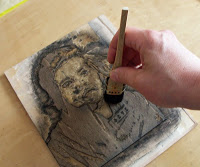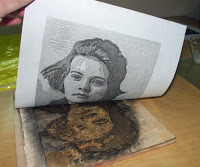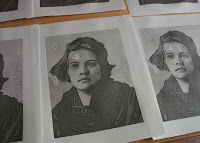After practicing on scrap blocks and paper for a week or two, I
decided to take the plunge and attempt a *real*
print using this method.
I wanted to use my usual reduction technique to see
how well it would work. After all, the paper has
to be dampened, printed and then dried (for each separate shade of gray)
before being able to
move on to the next cutting stage and I wasn’t sure how
the paper would hold up to that much abuse. So far, so good.
 This is my set up for inking. Nori (rice paste) on the left,
This is my set up for inking. Nori (rice paste) on the left,
diluted Sumi ink in the middle, and my inking brush
resting in the glass on the right.
Traditionally, the ink & nori are mixed together
directly on the surface of the block. I felt more
comfortable mixing on the glass slab
and transferring the mixture to the block
with the brush.
 Ink/nori mixture is applied to the block
Ink/nori mixture is applied to the block
using a circular pattern first, and then brushing across
the wood grain to even it out. It’s unlike “normal”
relief printing, because here the ink is so diluted that it
appears that nothing is on the block.
Sumi can be diluted with water to make every
imaginable shade of gray.
This is the fifth shade of gray that I’m printing, and I’ll
probably do 2-3 more before I run out of wood.
 Pulling a print here. I’ve made numerous mistakes
Pulling a print here. I’ve made numerous mistakes
working on this block (luckily it’s a small one!), but it’s been
a valuable learning experience.
My normal way
of working on a block doesn’t necessarily work
with this method. I like to use a dremel, which
raises a burr along the cut edge. That usually isn’t
a problem, but here the ink/nori mixture
collects on the burr and tends to print darker
than the surrounding area.
It’s also tricky determining the amount of
nori to ink ratio. if not enough is used, the ink will
print with a speckled appearance. Too much
and the block surface will get gloppy
and the paper could potentially stick
to the block.
 The prints are laid out to dry a bit. The paper
The prints are laid out to dry a bit. The paper
tends to buckle and warp so once they are
almost dry, they get stacked on top of each other
and are pressed under a weight to flatten them out.
No need to worry about ink transferring
from print to print as the ink is absorbed into
the fibers of the paper as apposed to
laying on the surface like an oil based
ink would do.